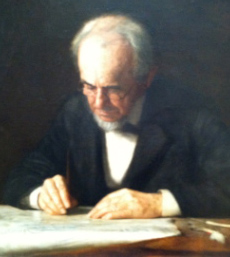The Bosenbury and Taylor Graveyards
This post is published in conjunction with a recent article on Bowne Station, because in that article Mr. Bush recalled the Bosenbury family, and the trouble they had burying old Cornelius Bosenbury. In this article, Mr. Bush went looking for that cemetery.
Bowne Station
This article by Egbert T. Bush answers some questions about the Bowne farm that were raised in the previous post, “Dr. Bowne’s Homestead.“1 Lora Olsen had pointed out that there were two houses on the property, one quite old, and one built in the mid 19th century. But it turns out there was a third house—one built for the slaves that lived on the farm.
Dr. Bowne’s Homestead
This article is meant as a companion to the article by Egbert T. Bush, “The Daybooks of Dr. Bowne.” In this article, Mr. Hoppock goes on at some length about the first owner of the Bowne farm being Jacob Moore. Unfortunately, he was mistaken. As Mr. Bush wrote, Jacob Moore settled on what later became known as the Wagner farm (at Haines and Wagner Roads). The Bowne farm was first settled by Peter Moore, but Mr. Bush does not say when he settled there. It was certainly early, because Peter Moore’s executors (his three sons) sold the farm to Dr. Bowne in 1795.
The Daybooks of Dr. Bowne
Recently I attended a workshop given by archivist Don Cornelius on the holdings of the Hunterdon County Historical Society. They are extensive, far more than I realized. Among them are the original daybooks of Dr. John Bowne of old Amwell Township, filled with the names of his patients and their treatment. These Daybooks are so important to genealogists that someone at the Historical Society has gone to the considerable effort of indexing the names into a card catalog, and—primitive as it may seem to be today—it’s a very useful genealogical tool for the time period of 1791 through 1857.
The ‘Wickcheoche’ Tribe of Red Men
Many years ago, Bob Dilts wrote an article entitled “Sergeantsville’s a Nicer Name.”1 While describing George Fisher’s harness shop (pictured below), on the southeast corner of the main intersection, Dilts wrote a paragraph that really caught my attention:
The Two John Barbers
In the early 1860s, two men named John Barber got involved on opposite sides of the question – should the country support Lincoln’s prosecution of the Civil War, or should it not?1
Ellicott’s Diary, August 1863
This is the last month of Benjamin H. Ellicott’s Diary. He continues to report on war news from his home in Baltimore, but, on August 18th he describes a visit to Croton, New Jersey on August 11th that leads him and wife Mary Ann Warford to decide to relocate there. But he does not explain why that decision was made. Perhaps they felt that the war was getting too close to them. Or maybe Mary Ann’s father, Elisha Warford, was asking them to come live with him.
Much Mischief Was Blamed on a Witch
The Good Old People Could Identify Her and Tell of Her Doings
She Rode on a Broomstick
by Egbert T. Bush, Stockton, N.J.
published in the Hunterdon County Democrat, May 1, 1930
Democrats & Union Men, continued
Here are some more of the Delaware Township gentlemen who took sides during the early years of the Civil War—men who joined the Democratic Club of Delaware Township in 1863, and also men living in the same vicinity who supported the Administration.1
